Lợi ích cảm nhận của thương mại di động đối với khách hàng tại thành phố Hồ Chí Minh: Tiếp cận với khái niệm đa chiều
Số lƣợng ngƣời dùng các thiết bị di động ngày càng tăng, cùng với sự phát triển của công nghệ
mạng không dây đã tạo ra sự bùng nổ thƣơng mại di động di động từ năm 2015 tại Việt Nam nói chung
và Thành phố Hồ Chí Minh nói riêng. Mặc dù là một loại hình nhiều tiềm năng, nhƣng mức độ phát triển
của các doanh nghiệp kinh doanh qua thiết bị di động đang có xu hƣớng giảm trong những năm gần đây,
và khách hàng cũng kém hào hứng với hình thức giao dịch này. Do đó, doanh nghiệp phải cung cấp nhiều
lợi ích cho khách hàng để thu hút khách hàng mới, cũng nhƣ giữ chân khách hàng cũ. Nghiên cứu nhằm
khám phá và đánh giá những lợi ích cảm nhận của thƣơng mại di động mang đến cho khách hàng tại thị
trƣờng trực tuyến Việt Nam, cụ thể tại Thành phố Hồ Chí Minh. Kết quả nghiên cứu định tính và định
lƣợng đã chỉ ra bốn lợi ích chính của thƣơng mại di động đối với khách hàng bao gồm sự thuận tiện, sự
lựa chọn, mua sắm tiêu khiển, và tính dễ truy cập. Đồng thời, nghiên cứu cũng đề xuất các hàm ý quản trị
cho các doanh nghiệp kinh doanh thông qua các ứng dụng trên thiết bị di động.
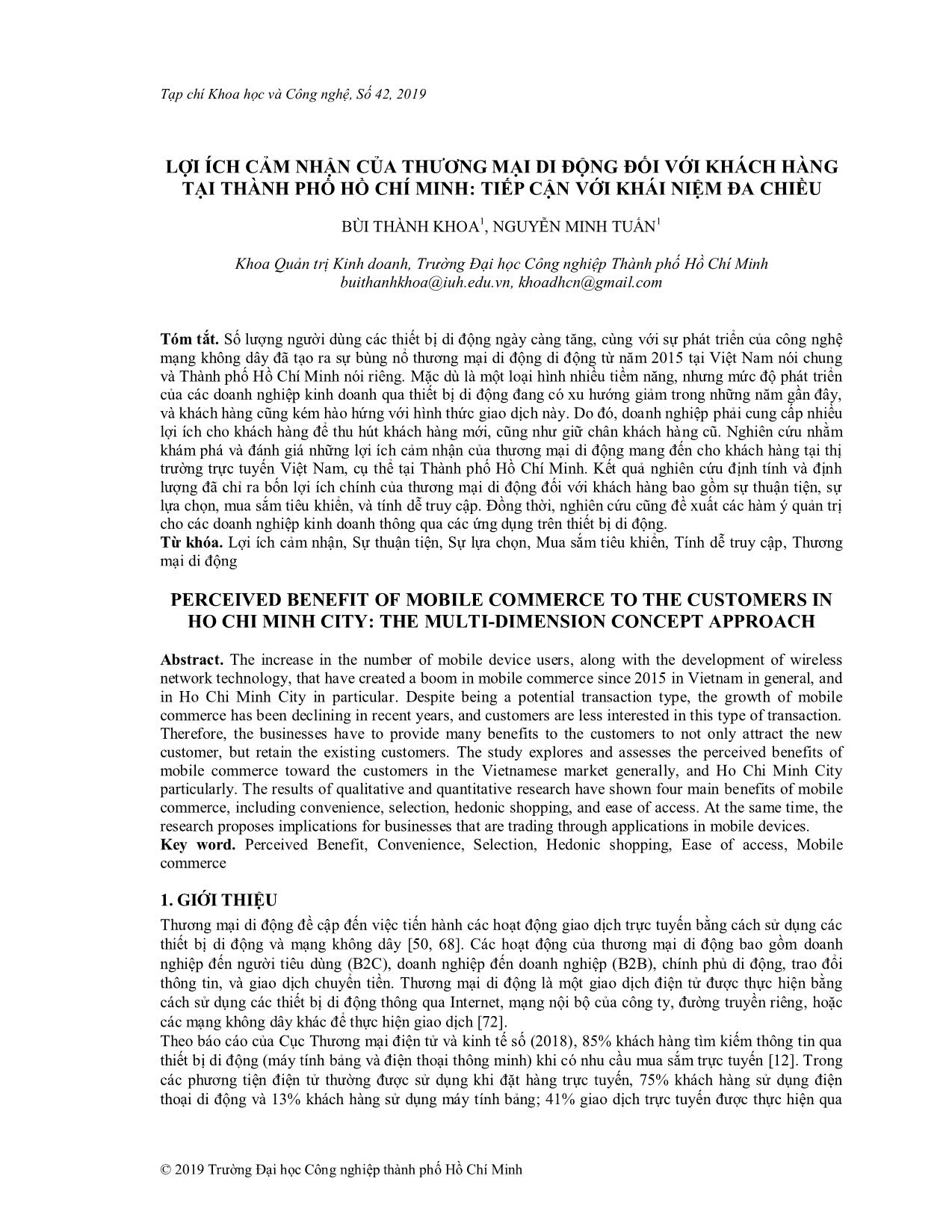
Trang 1
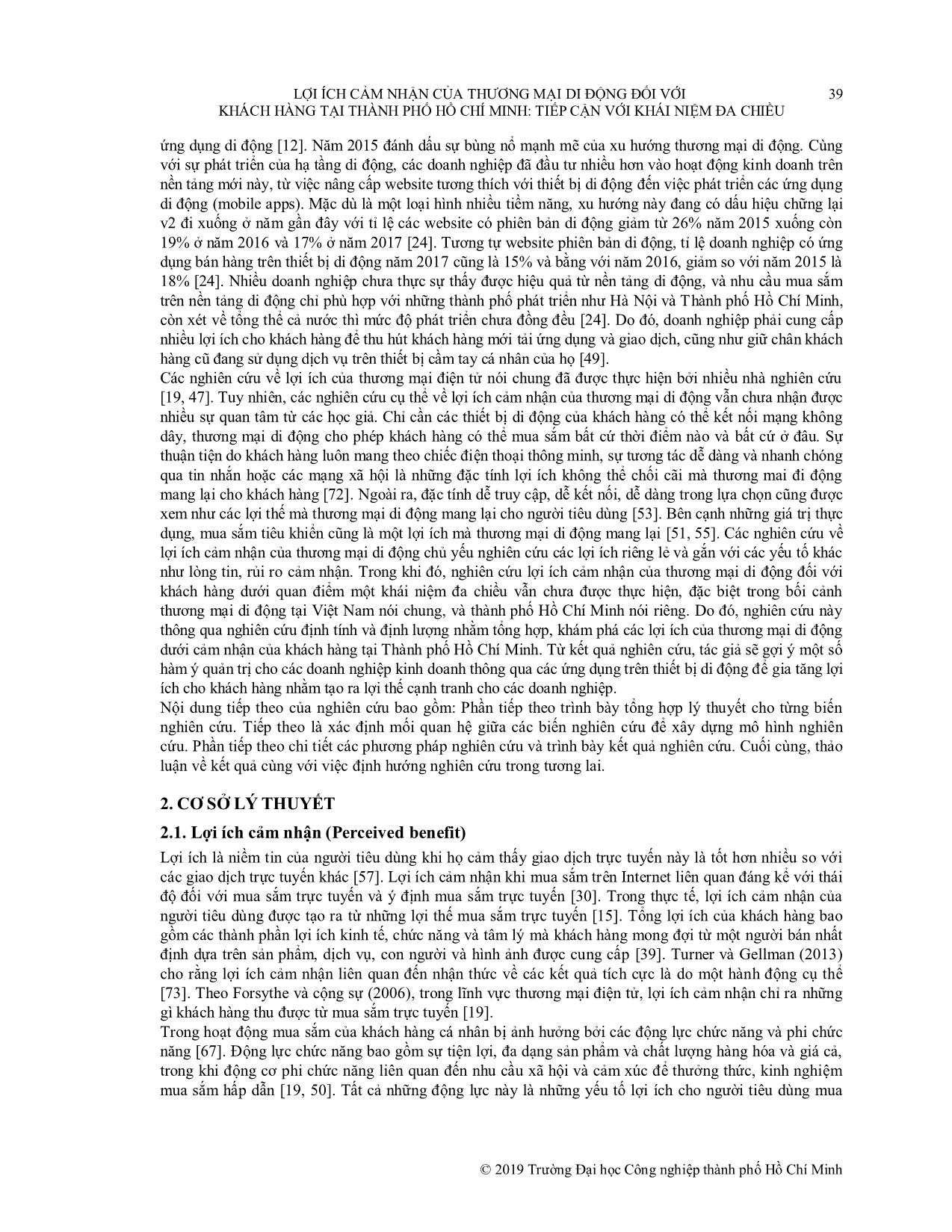
Trang 2
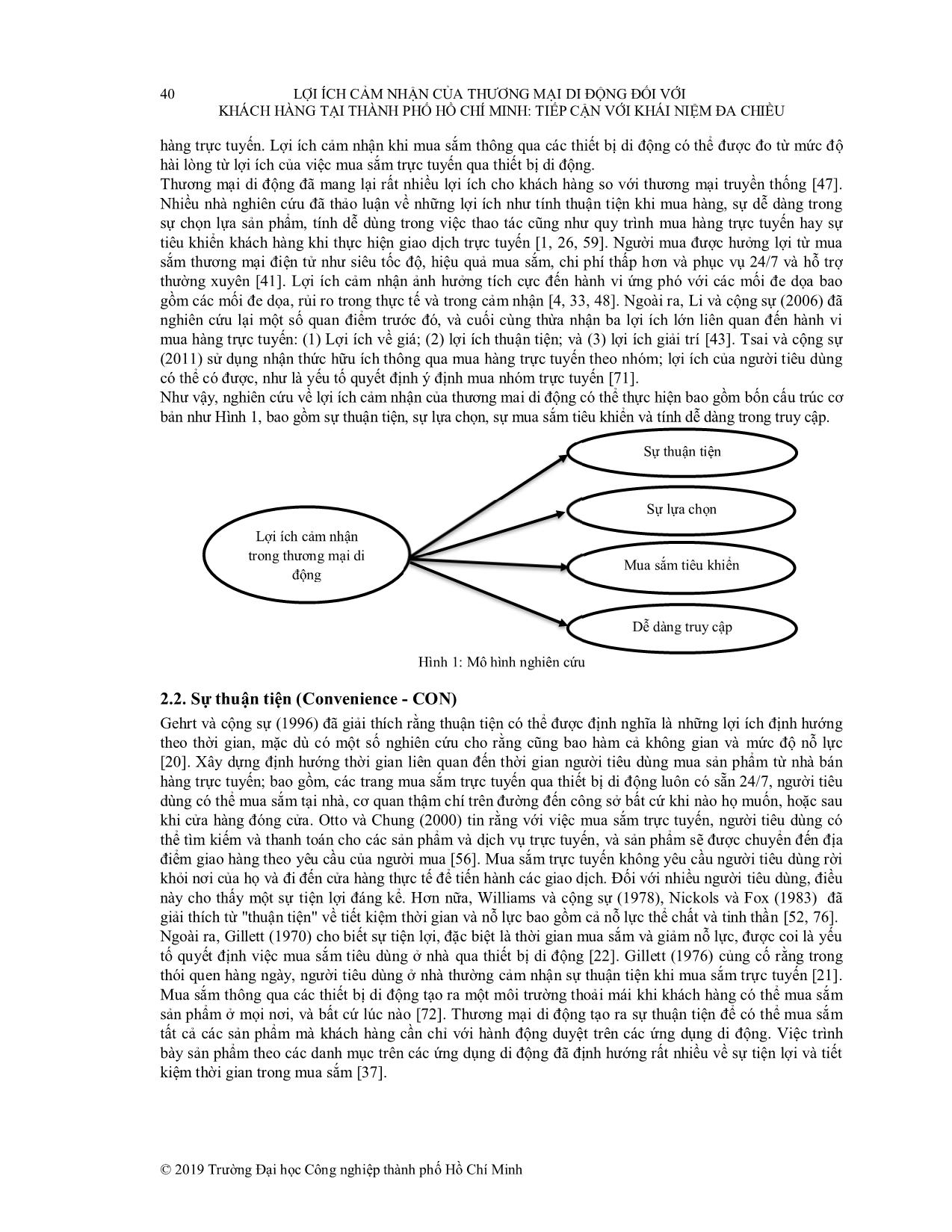
Trang 3
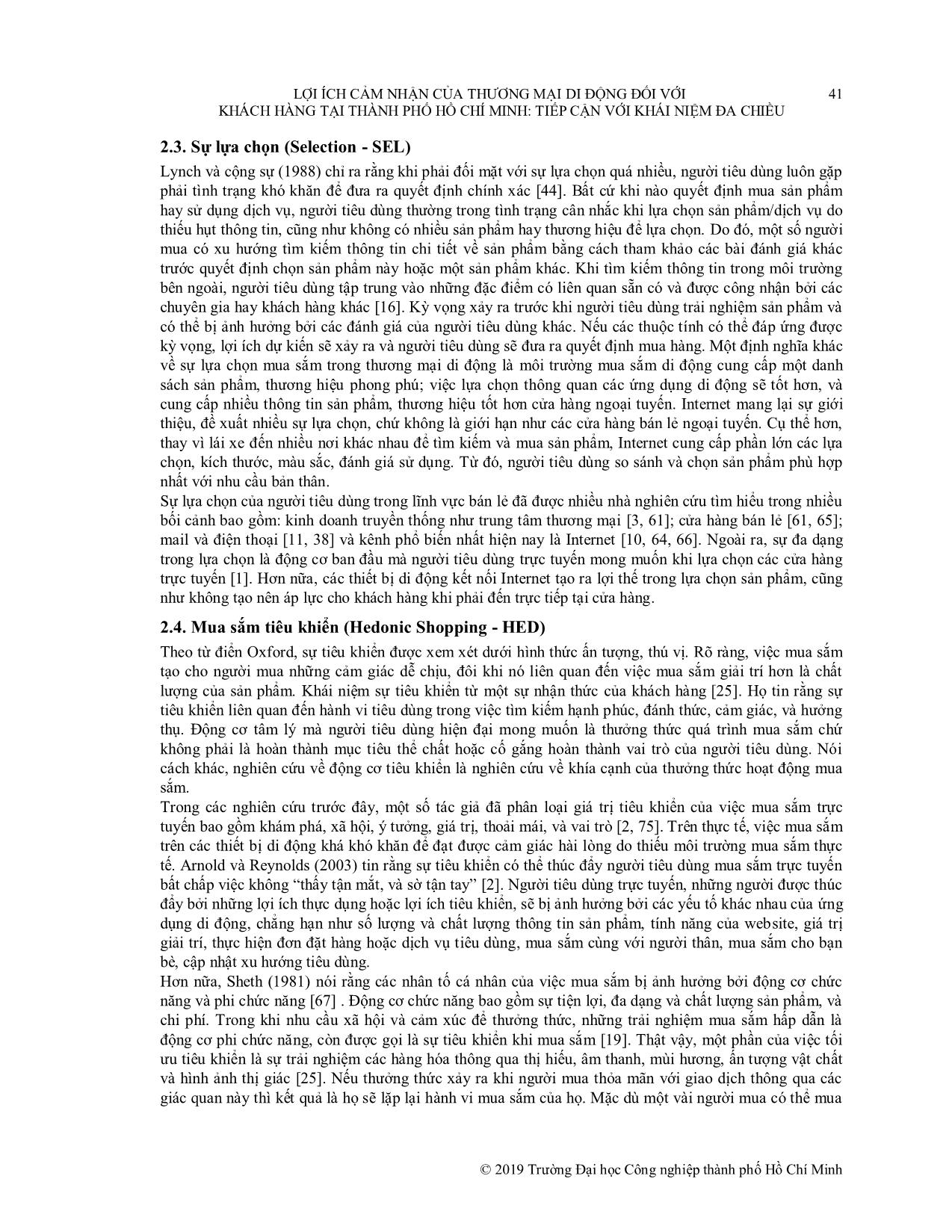
Trang 4
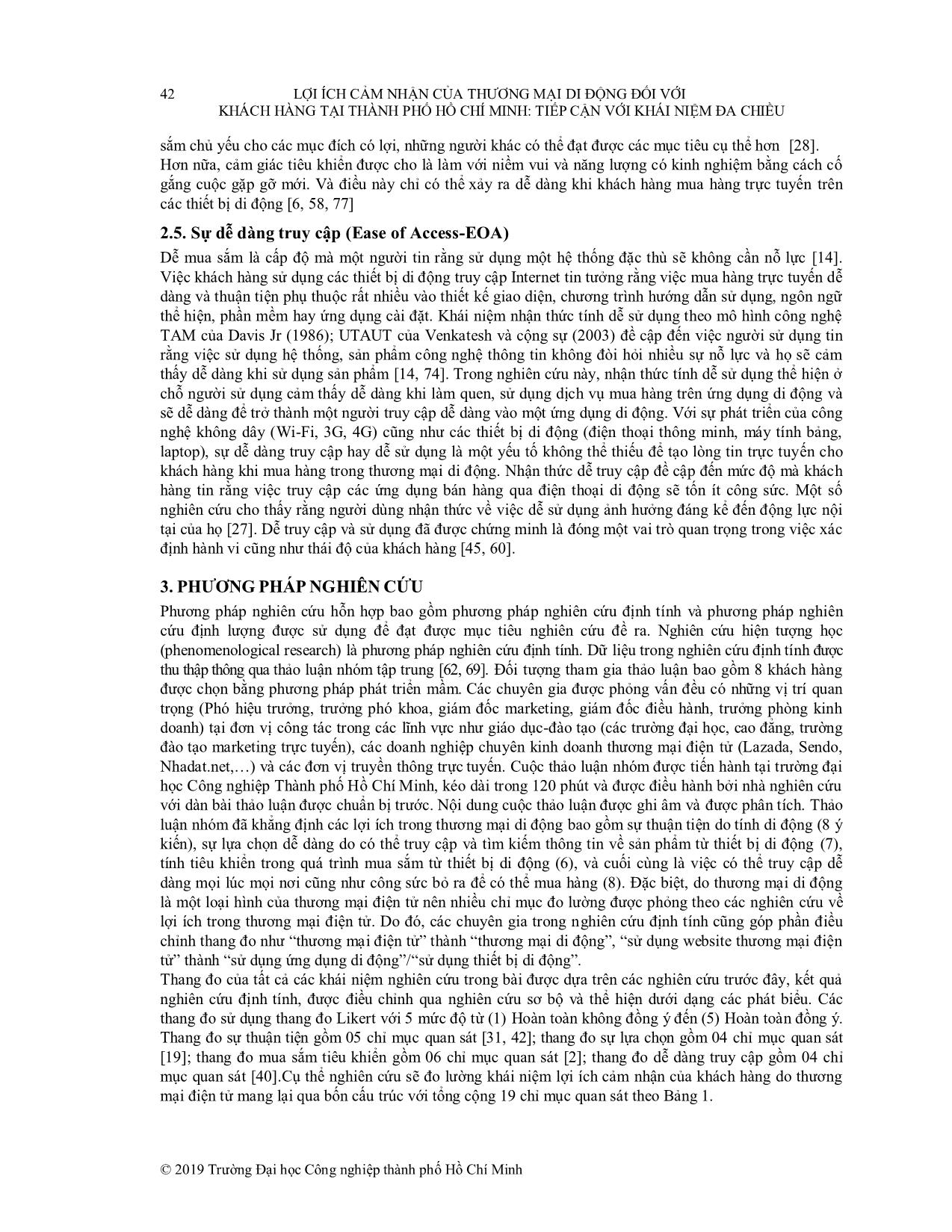
Trang 5
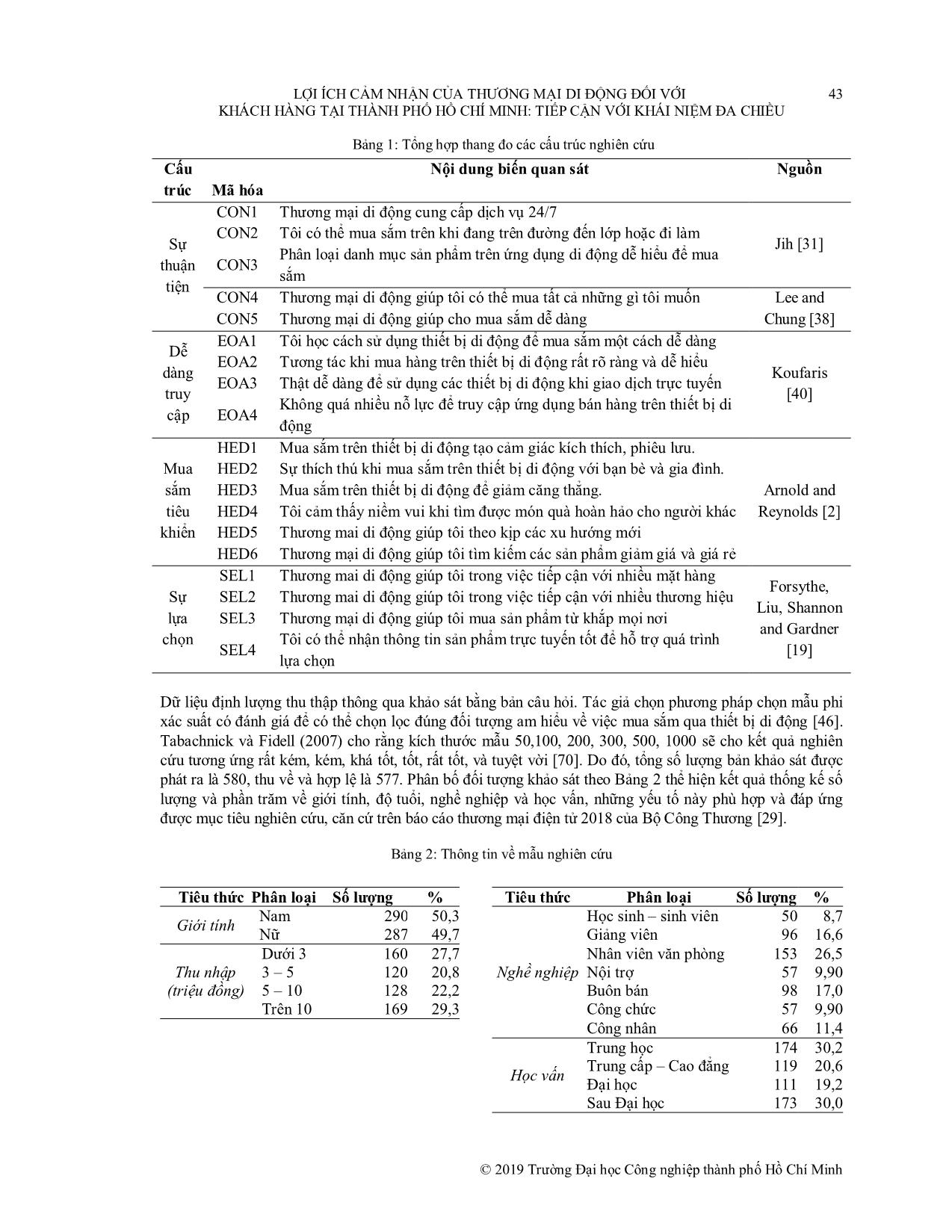
Trang 6
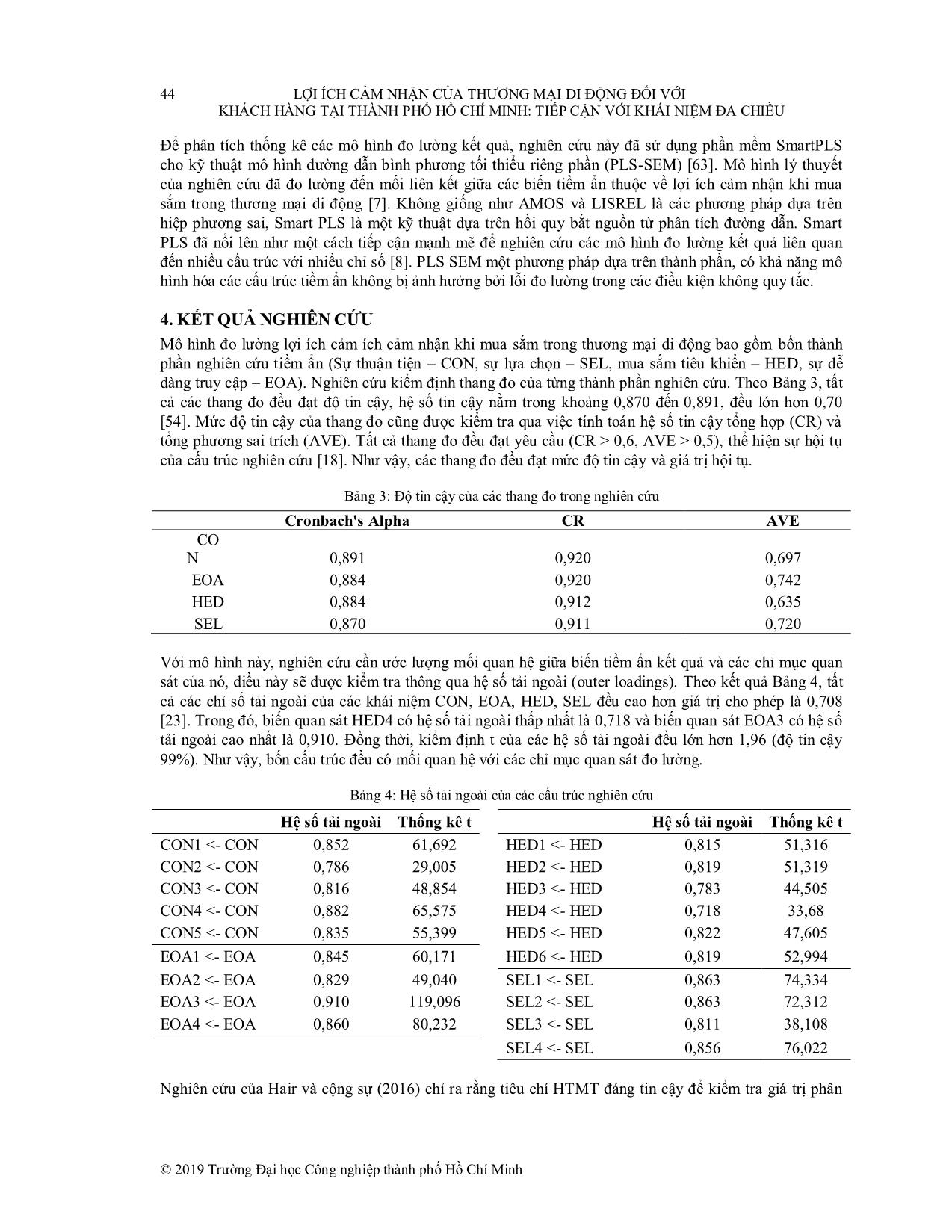
Trang 7
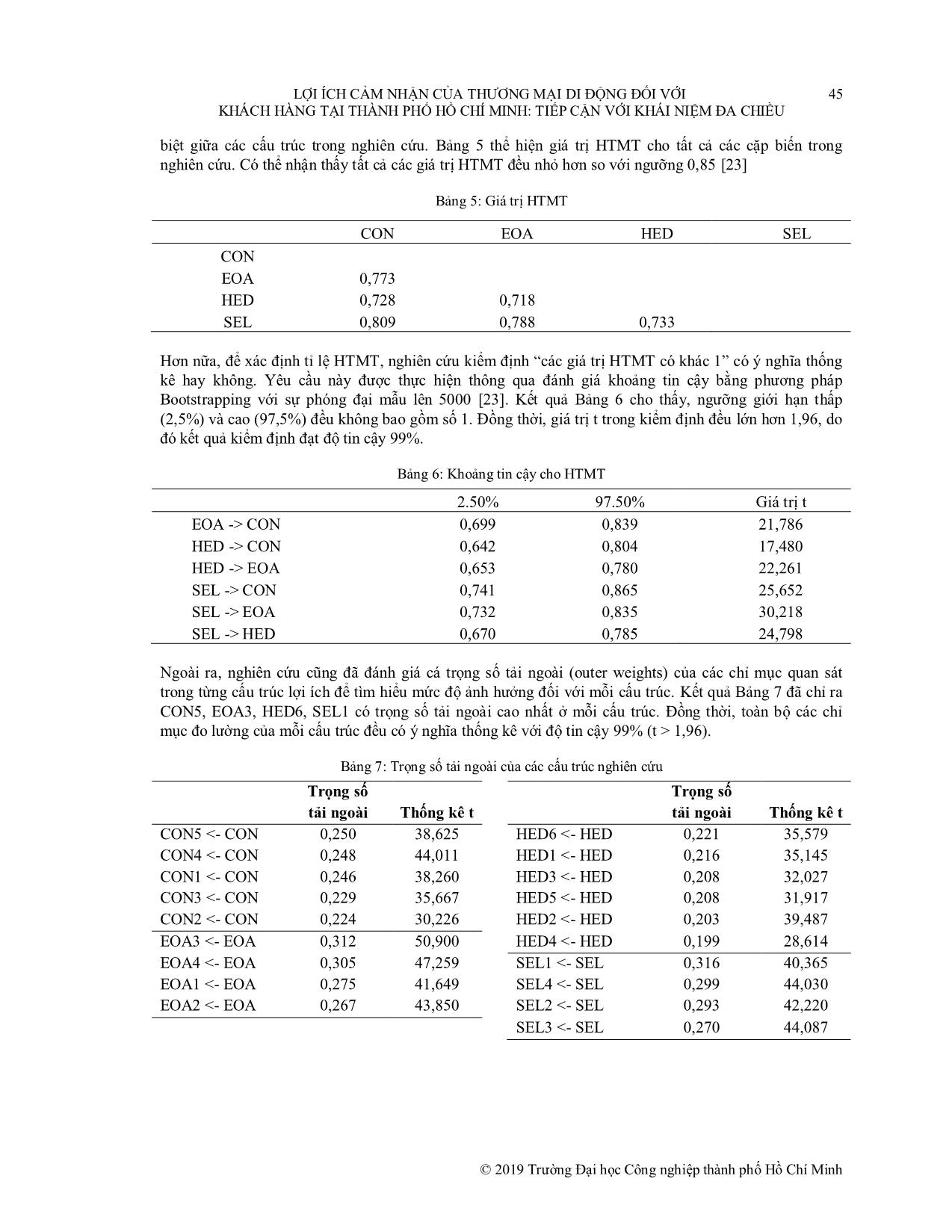
Trang 8
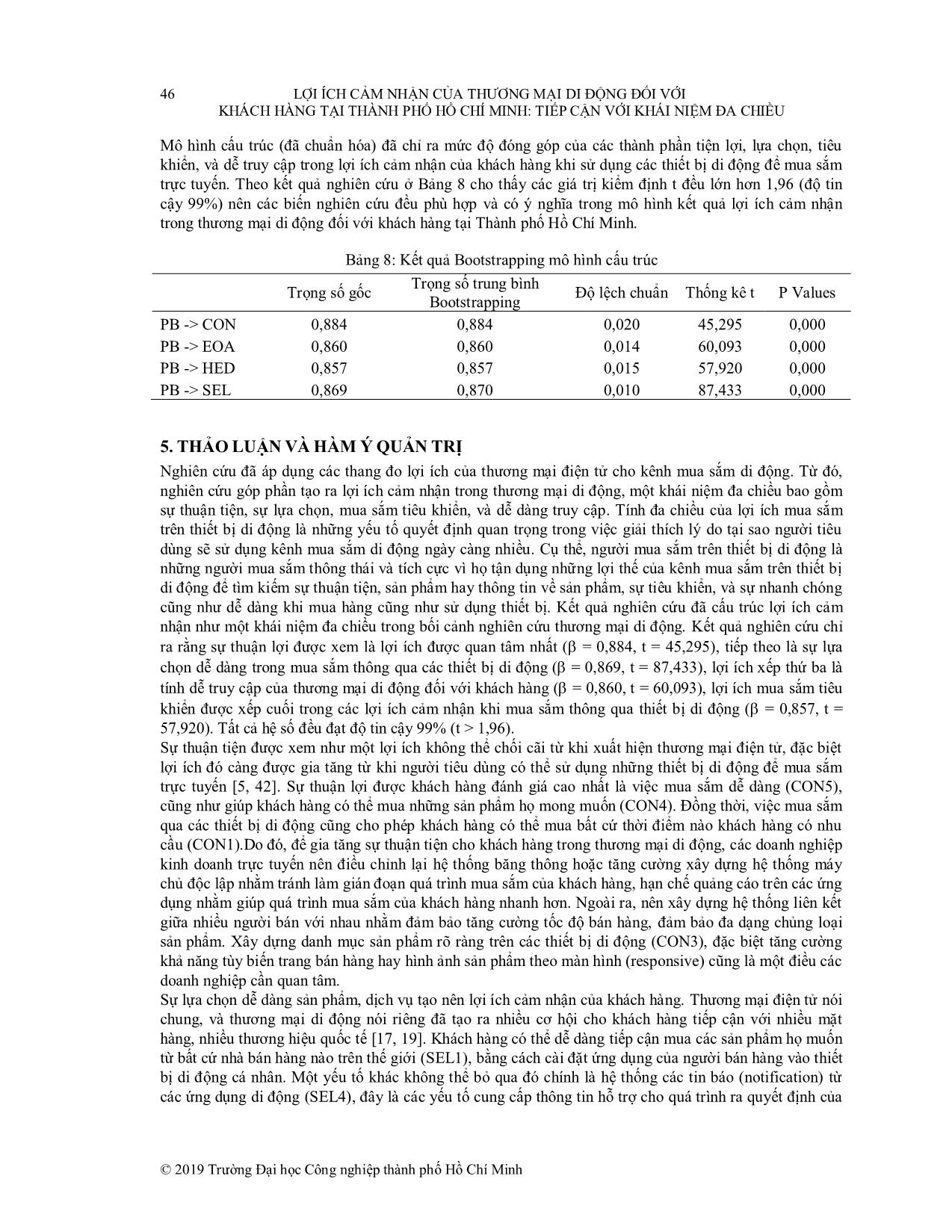
Trang 9
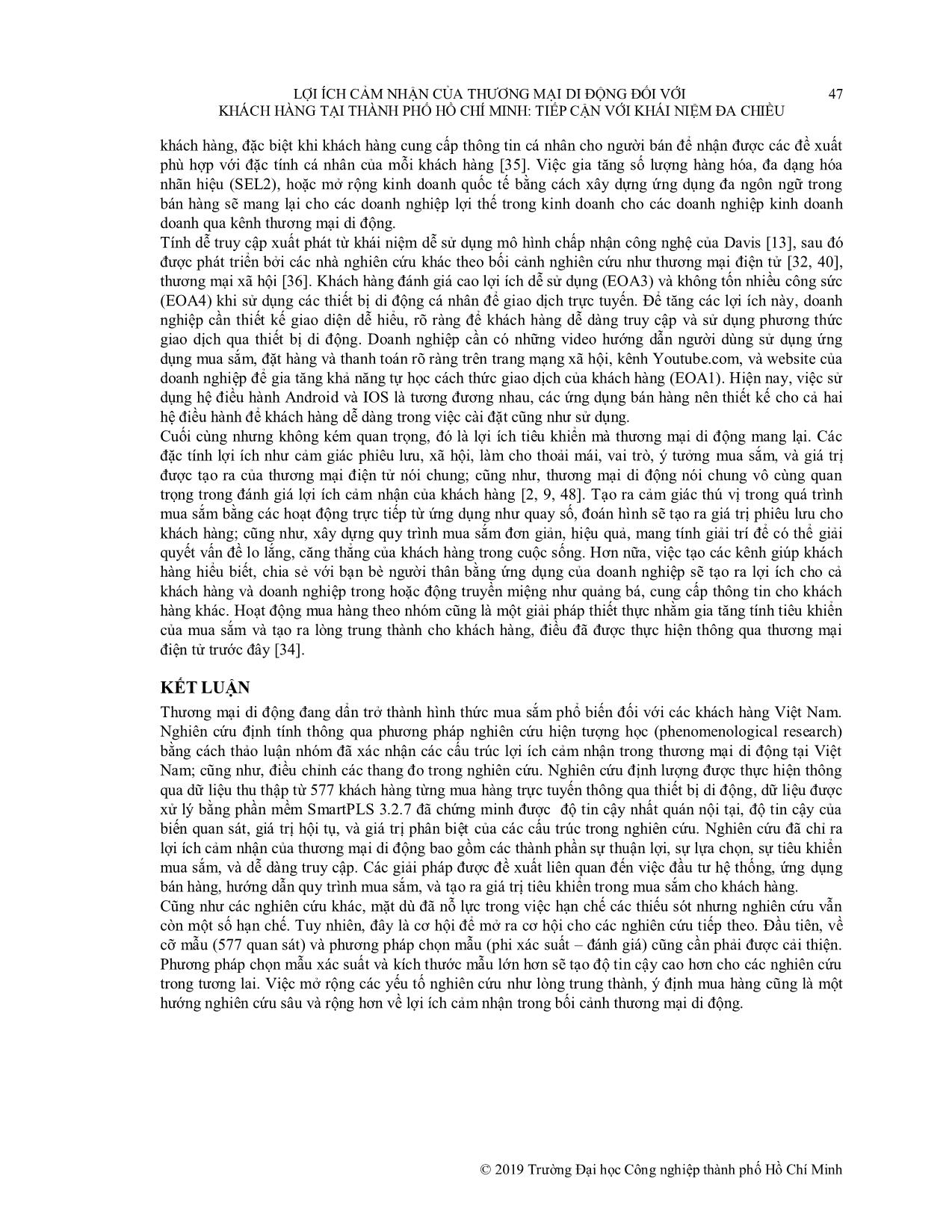
Trang 10
Tải về để xem bản đầy đủ
Tóm tắt nội dung tài liệu: Lợi ích cảm nhận của thương mại di động đối với khách hàng tại thành phố Hồ Chí Minh: Tiếp cận với khái niệm đa chiều
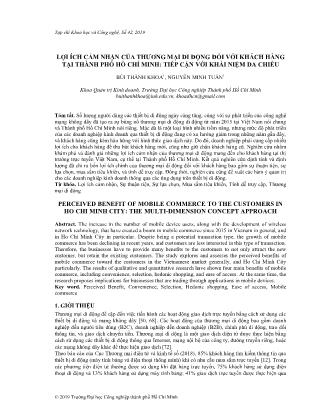
yếu tố nghiên cứu nhƣ lòng trung thành, ý định mua hàng cũng là một hƣớng nghiên cứu sâu và rộng hơn về lợi ích cảm nhận trong bối cảnh thƣơng mại di động. 48 LỢI ÍCH CẢM NHẬN CỦA THƢƠNG MẠI DI ĐỘNG ĐỐI VỚI KHÁCH HÀNG TẠI THÀNH PHỐ HỒ CHÍ MINH: TIẾP CẬN VỚI KHÁI NIỆM ĐA CHIỀU © 2019 Trƣờng Đại học Công nghiệp thành phố Hồ Chí Minh TÀI LIỆU THAM KHẢO [1] J. Alba, J. Lynch, B. Weitz, C. Janiszewski, R. Lutz, A. Sawyer, and S. Wood, “Interactive home shopping: consumer, retailer, and manufacturer incentives to participate in electronic marketplaces,” The Journal of Marketing, pp. 38-53, 1997. [2] M. J. Arnold, and K. E. Reynolds, “Hedonic shopping motivations,” Journal of retailing, vol. 79, no. 2, pp. 77-95, 2003. [3] N. L. Cassill, N. C. Williamson, M. McEnally, and J. Thomas, “Department store cross-shoppers,” Journal of Applied Business Research, vol. 10, no. 4, pp. 88, 1994. [4] P. Chandon, B. Wansink, and G. Laurent, “A benefit congruency framework of sales promotion effectiveness,” Journal of marketing, vol. 64, no. 4, pp. 65-81, 2000. [5] Y.-F. Chen, and Y.-C. Lan, "An empirical study of the factors affecting mobile shopping in Taiwan," Mobile Commerce: Concepts, Methodologies, Tools, and Applications, pp. 1329-1340: IGI Global, 2018. [6] T. L. Childers, C. L. Carr, J. Peck, and S. Carson, “Hedonic and utilitarian motivations for online retail shopping behavior,” Journal of retailing, vol. 77, no. 4, pp. 511-535, 2002. [7] W. W. Chin, and P. R. Newsted, “Structural equation modeling analysis with small samples using partial least squares,” Statistical strategies for small sample research, vol. 1, no. 1, pp. 307-341, 1999. [8] R. Chinomona, and J. Surujlal, “The influence of student internship work experience on their self- improvement and professionalism in Sport Management: sport management,” African Journal for Physical Health Education, Recreation and Dance, vol. 18, no. Issue-4_2, pp. 885-899, 2012. [9] C. M. Chiu, E. T. Wang, Y. H. Fang, and H. Y. Huang, “Understanding customers' repeat purchase intentions in B2C e‐ commerce: the roles of utilitarian value, hedonic value and perceived risk,” Information Systems Journal, vol. 24, no. 1, pp. 85-114, 2014. [10] J. M. Comer, R. Mehta, and T. L. Holmes, “Information technology: Retail users versus nonusers,” Journal of Interactive Marketing, vol. 12, no. 2, pp. 49-62, 1998. [11] D. Cox, and S. Rich, “Perceived risk and consumer decision-making: The case of telephone shopping,” Journal of marketing research, pp. 32-39, 1964. [12] Cục Thƣơng mại điện tử và kinh tế số, Sách trắng Thƣơng mại điện tử Việt Nam 2018, www.idea.gov.vn, 2018. [13] F. D. Davis, “Perceived usefulness, perceived ease of use, and user acceptance of information technology,” MIS quarterly, pp. 319-340, 1989. [14] F. D. Davis Jr, “A technology acceptance model for empirically testing new end-user information systems: Theory and results,” Massachusetts Institute of Technology, 1986. [15] N. Delafrooz, L. H. Paim, and A. Khatibi, “Understanding consumer's internet purchase intention in Malaysia,” African Journal of Business Management, vol. 5, no. 7, pp. 2837, 2011. [16] A. Dick, D. Chakravarti, and G. Biehal, “Memory-based inferences during consumer choice,” Journal of Consumer Research, vol. 17, no. 1, pp. 82-93, 1990. [17] M. A. Eastlick, and R. A. Feinberg, “Shopping motives for mail catalog shopping,” Journal of Business Research, vol. 45, no. 3, pp. 281-290, 1999. LỢI ÍCH CẢM NHẬN CỦA THƢƠNG MẠI DI ĐỘNG ĐỐI VỚI 49 KHÁCH HÀNG TẠI THÀNH PHỐ HỒ CHÍ MINH: TIẾP CẬN VỚI KHÁI NIỆM ĐA CHIỀU © 2019 Trƣờng Đại học Công nghiệp thành phố Hồ Chí Minh [18] C. Fornell, and D. F. Larcker, “Evaluating structural equation models with unobservable variables and measurement error,” Journal of marketing research, vol. 18, no. 1, pp. 39-50, 1981. [19] S. Forsythe, C. Liu, D. Shannon, and L. C. Gardner, “Development of a scale to measure the perceived benefits and risks of online shopping,” Journal of interactive marketing, vol. 20, no. 2, pp. 55-75, 2006. [20] K. C. Gehrt, L. J. Yale, and D. A. Lawson, “The convenience of catalog shopping: Is there more to it than time?,” Journal of Direct Marketing, vol. 10, no. 4, pp. 19-28, 1996. [21] P. L. Gillett, “In-home shoppers. An overview,” The Journal of Marketing, pp. 81-88, 1976. [22] P. L. Gillett, “A profile of urban in-home shoppers,” The Journal of Marketing, pp. 40-45, 1970. [23] J. F. Hair, G. T. M. Hult, C. Ringle, and M. Sarstedt, A primer on partial least squares structural equation modeling (PLS-SEM), London: Sage publications, 2016. [24] Hiệp hội Thƣơng mại điện tử Việt Nam, Chỉ số thƣơng mại điện tử Việt Nam 2018, www.vecom.vn, 2018. [25] E. C. Hirschman, and M. B. Holbrook, “Hedonic consumption: emerging concepts, methods and propositions,” The Journal of Marketing, pp. 92-101, 1982. [26] D. L. Hoffman, T. P. Novak, and P. Chatterjee, “Commercial scenarios for the web: opportunities and challenges,” Journal of Computer‐ Mediated Communication, vol. 1, no. 3, pp. 0-0, 1995. [27] C.-L. Hsu, and H.-P. Lu, “Consumer behavior in online game communities: A motivational factor perspective,” Computers in Human Behavior, vol. 23, no. 3, pp. 1642-1659, 2007. [28] C. Huffman, and M. J. Houston, “Goal-oriented experiences and the development of knowledge,” Journal of Consumer Research, vol. 20, no. 2, pp. 190-207, 1993. [29] IDEA., Thƣơng mại điện tử Việt Nam năm 2018, Cục thƣơng mại điện tử và kinh tế số, Hà Nội, 2019. [30] S. L. Jarvenpaa, and P. A. Todd, “Consumer reactions to electronic shopping on the World Wide Web,” International journal of electronic commerce, vol. 1, no. 2, pp. 59-88, 1996. [31] W.-J. Jih, “Effects of consumer-perceived convenience on shopping intention in mobile commerce: an empirical study,” International Journal of E-Business Research (IJEBR), vol. 3, no. 4, pp. 33-48, 2007. [32] B. T. Khoa, “Ảnh hƣởng của mạng xã hội đến lòng trung thành của khách hàng: Ứng dụng trƣờng hợp của Facebook,” Tạp chí Khoa học - Công nghệ, vol. 18, no. 1, pp. 86-97, 2015. [33] B. T. Khoa, “Ảnh hƣởng của rủi ro cảm nhận đến ý định mua hàng trực tuyến của khách hàng tại TP. Hồ Chí Minh,” Tap chí Khoa học và Công nghệ, vol. 34, no. 04, pp. 87-97, 2018. [34] B. T. Khoa, “Nghiên cứu các nhân tố tác động đến lòng trung thành của khách hàng mua hàng theo nhóm trên Internet,” Tạp chí Khoa học - Công nghệ, vol. 20, no. 3, pp. 99-111, 2015. [35] B. T. Khoa, “Nghiên cứu nhận thức bảo vệ thông tin riêng tƣ của ngƣời mua hàng trực tuyến tại TP.HCM,” Tạp chí Khoa học và Công nghệ, vol. 2, no. 26, pp. 66-76, 2017. [36] B. T. Khoa, and T. Khánh, “Nghiên cứu các yếu tố ảnh hƣởng đến lòng tin trực tuyến của khách hàng Việt Nam: Trƣờng hợp thƣơng mại xã hội,” Tap chí Công Thƣơng, vol. 5, no. 4/2019, pp. 198-204, 2019. [37] P. K. Korgaonkar, “Shopping orientations of catalog showroom patrons,” Journal of Retailing, vol. 57, no. 1, pp. 78-90, 1981. [38] P. K. Korgaonkar, and D. Bellenger, “Nonstore retailers and consumer characteristics,” Akron Business and Economic Review, vol. 14, no. 4, pp. 29-34, 1983. 50 LỢI ÍCH CẢM NHẬN CỦA THƢƠNG MẠI DI ĐỘNG ĐỐI VỚI KHÁCH HÀNG TẠI THÀNH PHỐ HỒ CHÍ MINH: TIẾP CẬN VỚI KHÁI NIỆM ĐA CHIỀU © 2019 Trƣờng Đại học Công nghiệp thành phố Hồ Chí Minh [39] P. Kotler, K. L. Keller, M. Goodman, M. Brady, and T. Hansen, Marketing management, Harlow: Pearson Education Limited, 2019. [40] M. Koufaris, “Applying the technology acceptance model and flow theory to online consumer behavior,” Information systems research, vol. 13, no. 2, pp. 205-223, 2002. [41] R. Law, and C. H. Hsu, “Importance of hotel website dimensions and attributes: perceptions of online browsers and online purchasers,” Journal of Hospitality & Tourism Research, vol. 30, no. 3, pp. 295-312, 2006. [42] K. C. Lee, and N. Chung, “Empirical analysis of consumer reaction to the virtual reality shopping mall,” Computers in Human Behavior, vol. 24, no. 1, pp. 88-104, 2008. [43] D. Li, G. J. Browne, and J. C. Wetherbe, “Why do internet users stick with a specific web site? A relationship perspective,” International journal of electronic commerce, vol. 10, no. 4, pp. 105-141, 2006. [44] J. G. Lynch Jr, H. Marmorstein, and M. F. Weigold, “Choices from sets including remembered brands: Use of recalled attributes and prior overall evaluations,” Journal of Consumer Research, vol. 15, no. 2, pp. 169-184, 1988. [45] E. Mao, M. Srite, J. Bennett Thatcher, and O. Yaprak, “A research model for mobile phone service behaviors: empirical validation in the US and Turkey,” Journal of Global Information Technology Management, vol. 8, no. 4, pp. 7-28, 2005. [46] W. L. Neuman, Social research methods: Qualitative and quantitative approaches, 7th ed., Harlow, United Kingdom: Pearson education, 2013. [47] H. M. Nguyen, and B. T. Khoa, “Perceived Mental Benefit in Electronic Commerce: Development and Validation,” Sustainability, vol. 11, no. 23, pp. 6587-6608, 2019. [48] H. M. Nguyen, and B. T. Khoa, “The Relationship between the Perceived Mental Benefits, Online Trust, and Personal Information Disclosure in Online Shopping,” The Journal of Asian Finance, Economics and Business, vol. 6, no. 4, pp. 261-270, 11/30, 2019. [49] M. H. Nguyen, and B. T. Khoa, “Customer Electronic Loyalty towards Online Business: The role of Online Trust, Perceived Mental Benefits and Hedonic Value,” Journal of Distribution Science, vol. 17, no. 12, pp. 81-93, 2019. [50] M. H. Nguyen, and B. T. Khoa, “A Study on the Chain of Cost - Values-Online Trust: Applications in Mobile Commerce in Vietnam,” Journal of Applied Economic Sciences, vol. 14, no. 1, pp. 269-280, 2019. [51] M. H. Nguyễn, and B. T. Khoa, “Lợi ích tinh thần cảm nhận khi mua hàng trực tuyến,” Tạp chí khoa học Đại học Mở Thành phố Hồ Chí Minh, vol. 14, no. 1, pp. 3-17, 2019. [52] S. Y. Nickols, and K. D. Fox, “Buying time and saving time: Strategies for managing household production,” Journal of Consumer Research, vol. 10, no. 2, pp. 197-208, 1983. [53] M. Niranjanamurthy, N. Kavyashree, S. Jagannath, and D. Chahar, “Analysis of e-commerce and m- commerce: advantages, limitations and security issues,” International Journal of Advanced Research in Computer and Communication Engineering, vol. 2, no. 6, pp. 2360-2370, 2013. [54] J. C. Nunnally, and I. Bernstein, “The assessment of reliability,” Psychometric theory, vol. 3, no. 1, pp. 248-292, 1994. [55] S. Okazaki, “New perspectives on m-commerce research,” Journal of Electronic Commerce Research, vol. 6, no. 3, pp. 160, 2005. LỢI ÍCH CẢM NHẬN CỦA THƢƠNG MẠI DI ĐỘNG ĐỐI VỚI 51 KHÁCH HÀNG TẠI THÀNH PHỐ HỒ CHÍ MINH: TIẾP CẬN VỚI KHÁI NIỆM ĐA CHIỀU © 2019 Trƣờng Đại học Công nghiệp thành phố Hồ Chí Minh [56] J. R. Otto, and Q. Chung, “A framework for cyber-enhanced retailing: Integrating e-commerce retailing with brick-and-mortar retailing,” Electronic Markets, vol. 10, no. 3, pp. 185-191, 2000. [57] C. Park, and Y. Kim, “The effect of information satisfaction and relational benefit on consumer’s online shopping site commitment,” Web Technologies for Commerce and Services Online, vol. 1, pp. 149, 2008. [58] A. G. Parsons, “Non-functional motives for online shoppers: why we click,” Journal of Consumer Marketing, vol. 19, no. 5, pp. 380-392, 2002. [59] R. A. Peterson, S. Balasubramanian, and B. J. Bronnenberg, “Exploring the implications of the Internet for consumer marketing,” Journal of the Academy of Marketing science, vol. 25, no. 4, pp. 329-346, 1997. [60] G. G. Pijpers, and K. van Montfort, “An investigation of factors that influence senior executives to accept innovations in information technology,” International Journal of Management, vol. 22, no. 4, pp. 542, 2005. [61] V. K. Prasad, “Socioeconomic product risk and patronage preferences of retail shoppers,” The Journal of Marketing, pp. 42-47, 1975. [62] F. Rabiee, “Focus-group interview and data analysis,” Proceedings of the nutrition society, vol. 63, no. 04, pp. 655-660, 2004. [63] C. Ringle, S. Wende, and A. Will, “SmartPLS version 2.0 M2,” Hamburg, Germany: Institute for Operations Management and Organization at the University of Hamburg, 2005. [64] J. Rowley, “Retailing and shopping on the Internet,” International Journal of Retail & Distribution Management, vol. 24, no. 3, pp. 26-37, 1996. [65] R. A. Schmidt, R. Segal, and C. Cartwright, “Two-stop shopping or polarization: whither UK grocery shopping?,” International Journal of Retail & Distribution Management, vol. 22, no. 1, pp. 12-19, 1994. [66] P. N. Shamdasani, and O. G. Yeow, “An exploratory study of in-home shoppers in a concentrated retail market: the case of Singapore,” Journal of Retailing and consumer Services, vol. 2, no. 1, pp. 15-23, 1995. [67] J. N. Sheth, An integrative theory of patronage preference and behavior: College of Commerce and Business Administration, Bureau of Economic and Business Research, University of Illinois, Urbana-Champaign, 1981. [68] K. Siau, E.-P. Lim, and Z. Shen, “Mobile commerce: Promises, challenges and research agenda,” Journal of Database Management (JDM), vol. 12, no. 3, pp. 4-13, 2001. [69] D. Silverman, Qualitative research, London: Sage, 2016. [70] B. Tabachnick, and L. Fidell, “Multivariate analysis of variance and covariance,” Using multivariate statistics, vol. 3, pp. 402-407, 2007. [71] M.-T. Tsai, N.-C. Cheng, and K.-S. Chen, “Understanding online group buying intention: the roles of sense of virtual community and technology acceptance factors,” Total Quality Management & Business Excellence, vol. 22, no. 10, pp. 1091-1104, 2011. [72] E. Turban, J. Outland, D. King, J. K. Lee, T.-P. Liang, and D. C. Turban, Electronic Commerce 2018: A Managerial and Social Networks Perspective, Cham, Switzerland: Springer, 2017. [73] J. R. Turner, and M. Gellman, Encyclopedia of Behavioral Medicine, New York, NY: Springer, 2013. [74] V. Venkatesh, M. G. Morris, G. B. Davis, and F. D. Davis, “User acceptance of information technology: Toward a unified view,” MIS quarterly, pp. 425-478, 2003. [75] R. A. Westbrook, and W. C. Black, “A motivation-based shopper typology,” Journal of retailing, 1985. 52 LỢI ÍCH CẢM NHẬN CỦA THƢƠNG MẠI DI ĐỘNG ĐỐI VỚI KHÁCH HÀNG TẠI THÀNH PHỐ HỒ CHÍ MINH: TIẾP CẬN VỚI KHÁI NIỆM ĐA CHIỀU © 2019 Trƣờng Đại học Công nghiệp thành phố Hồ Chí Minh [76] R. H. Williams, J. J. Painter, and H. R. Nicholas, “Policy-oriented typology of grocery shoppers,” Journal of Retailing, vol. 54, no. 1, pp. 27-42, 1978. [77] M. Wolfinbarger, and M. C. Gilly, “Shopping online for freedom, control, and fun,” California Management Review, vol. 43, no. 2, pp. 34-55, 2001. Ngày nhận bài: 12/09/2019 Ngày chấp nhận đăng: 25/02/2020
File đính kèm:
 loi_ich_cam_nhan_cua_thuong_mai_di_dong_doi_voi_khach_hang_t.pdf
loi_ich_cam_nhan_cua_thuong_mai_di_dong_doi_voi_khach_hang_t.pdf

